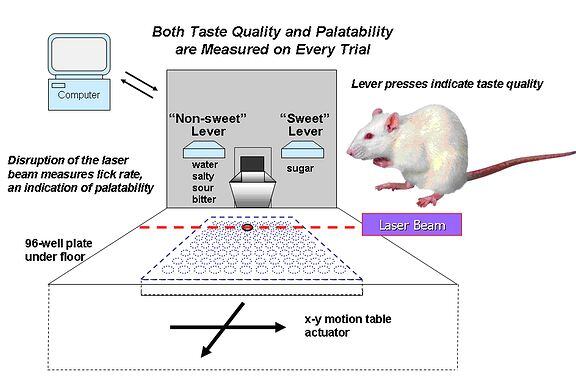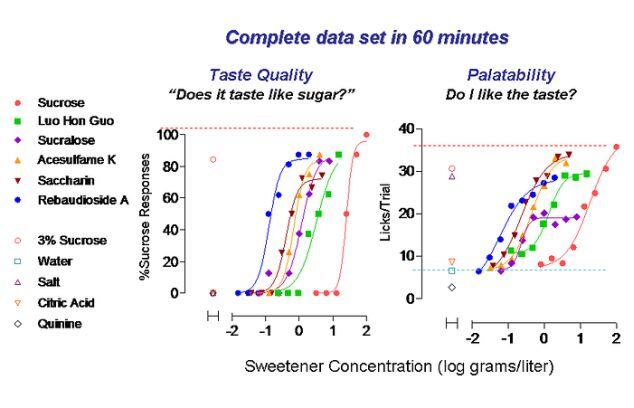Currently, firms have several options when it comes to high-throughput flavor testing, says chief science officer Dr Kyle Palmer, who says interest in the technology has come from top tier flavor companies, food and beverage manufacturers and firms that develop products for these companies.
What’s unusual about this is not only that we’re measuring palatability at the same time as quality
First, they can use cell-based assays, a quick way to test interactions between thousands of tastants or taste modifiers and taste receptors (eg. if substance X stimulates sweet taste receptor Y, it could be sweet) used by firms such as Senomyx to narrow down samples of interest from vast chemical libraries.
However, these tests don’t measure palatability (does substance X taste nice?) or potency (how much sweeter is sample A than B?), he said. They can also miss things humans and animals can pick up; for example, substance A might be sensed by rats as sweet, but does not work by stimulating sweet receptors.
Animal tests, by contrast, are frequently used to determine palatability (though lick rates etc) or quality (is substance x bitter?) of a smaller number of samples, separately.
What makes Opertec Bio’s Microtiter Operant Gustometer (MOG) unique is that it can measure both of these things at the same time, and it’s fast, enabling clients to assess 96 samples in a single 90-minute session.
All 96 samples were evaluated within 90 minute test sessions with no evidence of desensitization or fatigue
As such, the MOG offers a more cost effective approach to sensory evaluation, added Dr Palmer, who is the lead author of a paper outlining how the MOG works just published in the journal PLOS ONE (click here).
“The MOG can be used to discover new flavor ingredients, measure flavor palatability and optimize flavor formulations.
“What’s unusual about this is not only that we’re measuring palatability at the same time as quality, which saves time and money, but the rate of licking in our system is largely independent of motivational factors like thirst or hunger, so it’s a more accurate reflection of palatability.”
How does it work?
But how does it work?
The MOG uses rats trained to become expert taste testers, he explained.

Over a period of weeks, the rats are trained to press levers for a food pellet reward after they have tasted flavor samples in a 96-well plate at the bottom of the MOG. To get the pellet, they must press the right lever if the solution is a standard (eg. sweet) and the left lever if the solution presented has any other taste (non-standard).
Uniquely, the system also measures the palatability of flavor samples by counting the number of times the rat’s tongue enters the well (the path of a laser beam projected across the top of the well is disrupted each time the rat licks a sample), said Dr Palmer.
“The rats were trained to discriminate 100 mM sucrose from water, quinine, citric acid, and NaCl with 90-100% accuracy. All 96 samples were evaluated within 90 minute test sessions with no evidence of desensitization or fatigue.”
Conducting experiments with human taste panels can be resource-intensive

But why not just use humans, who can tell you all about taste quality, intensity, and palatability at the same time?
Lots of reasons, said Dr Palmer, the first being that you can’t make humans lick or swallow scores of substances that haven’t gone through safety tests, and it’s not cost effective to conduct safety tests on 1,000s of samples before you conduct human sensory tests when in all likelihood only a handful might have commercial potential, he said.
Second, humans can’t process as many samples as rats in a session. And third, human sensory testing is expensive, and humans need larger sample sizes, which is very costly when you’re assessing natural flavor ingredients, he added.
“Conducting experiments with human taste panels can be resource-intensive and relatively limited in flexibility of experimental design”, said Dr Palmer.
We’re not competing with other techniques
Firms can use the MOG in conjunction with other techniques, so once they have used cell-based assays to identify say, 100 samples of interest from a big library, they can then use the MOG to further narrow the sample size down before homing in on a handful of substances that they can then test with humans, said Dr Palmer.
“We see all of these techniques as synergistic. We think there is a significant opportunity to streamline the flavor discovery process.”
Results of MOG tests have been fully validated by human taste tests
But are rats’ taste-buds sufficiently similar to humans’ to make the MOG accurate for identifying, say, novel sweeteners?
Yes, said Dr Palmer.“We know there is considerable overlap between the two species, not only with respect to the many different kinds of sweeteners both species detect, but also in the concentration ranges in which the sweeteners are active.”
Meanwhile, the results of MOG tests have been “fully validated” by human taste tests conducted by Opertech Bio’s clients, added Dr Palmer, who said patent applications have been filed describing the method and the apparatus for the high-throughput screening.
The business model at present is a service model, he said. “Customers send us compounds for evaluation and we share the data with them.”
The next step is expanding the MOG platform to pets such as dogs, he said.
“The behavioral principles and methodology underlying its success are universal to all species. We are currently pursuing the extension of the MOG technology platform to accommodate companion animals and humans."
Source: PLOS One August 12, 2013
‘A High Throughput In Vivo Assay For Taste Quality and Palatability’
Authors: R. Kyle Palmer, Daniel L. Long, Francis X. Brennan, Tulu Buber, Robert W. Bryant, and F. Raymond Salemme.

